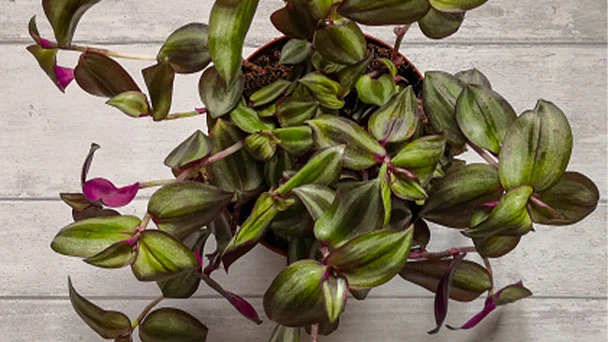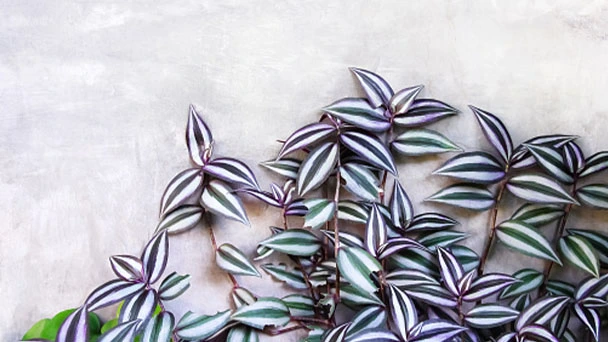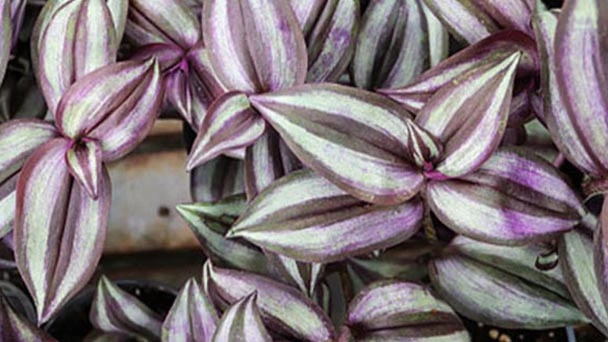Inch Plant Grow, Care and Propagation Guide 2021
Written by Ivy
Nov 12 2021

Inch plant is a kind of evergreen herb. Inch plant's roots are very fragile and grow slowly on the ground. So why is it called inch plant? Because its leaves are as beautiful as bamboo, inch plant is often made into a potted plant hanging indoors, and then enjoy its very beautiful stems and leaves.

Read More:
12 Popular Evergreen Plants with Pictures for Beginners
In normal maintenance, it is also necessary to fully scatter sunlight to the inch plant, so that the whole plant can grow more lush and the color of the leaves will become more green. However, we must not directly expose the inch plant to strong sunlight. When the sun is too strong, the color of the leaves will darken. In serious cases, the leaves will turn yellow and wither. If the inch plant is placed indoors for cultivation, it needs to be placed in an outdoor shade for a period of time every two months so that it can accumulate enough nutrition and grow healthily.
The most suitable temperature for growth of inch plant is between 15 and 25 degrees. It is not cold resistant, so the temperature must be higher than 10 degrees in winter. If the ambient temperature of hanging bamboo plum drops to about 5 degrees, the inch plant will enter a dormant state. If the temperature continues to drop, frostbite will occur after reaching zero, causing it to wither and other symptoms.
In the pest control of inch plant, aphids must be paid attention to and removed as soon as possible when they are found. First, we need to trim the branches and leaves with pests. Secondly, we need to spray 50% marathon emulsion diluted into 1000 times solution. Finally, we need to strengthen the maintenance and management at the back to make the environment more ventilated and moderate humidity. We should find the diseased branches and leaves of inch plant and remove them, then spray gebizhi and dilute it to 750-1000 times. Then we should ensure that inch plant can enjoy sufficient light during normal maintenance, and do scientific fertilization to improve its resistance.
Then insert the treated inch plant branch into the bottle prepared in advance and fix it vertically to ensure that it will not tilt and fall down. Then put the whole bottle in a shady place to avoid direct sunlight. The best temperature is 21 ℃ to 28 ℃. (Find more vine plants indoor here.)
We need to change the water seven days after completing the inch plant propagation in water to ensure that the water is clean. At the same time, we should pay attention to cleaning the roots of branches to prevent rot or bacterial infection from causing pests. When changing water, add nutrient solution to ensure energy supply.
The water can be changed once every three days in the initial stage of inch plant propagation in water. Because the branches of hanging bamboo plum are delicate and easy to break, special care should be taken when changing water. In order to avoid breaking the branches, we don't need to take the branches when changing the water. We just need to turn the vase upside down to drain the water, gently hold the upside down branches with our hands, and then change into clean water. We can change the water once ten days after it takes root.
Read Next:
20 Popular Vine Plants Indoor To Grow
Inch Plant Quick InfoInch Plant Care in DetailInch Plant WateringInch Plant SoilInch Plant LightInch Plant TemperatureInch Plant HumidityInch Plant FertilizerInch Plant PruningInch Plant RepottingInch Plant Pest & Disease ControlInch Plant PropagationInch Plant Propagation from CuttingInch Plant Propagation from DivisionInch Plant Propagation in WaterInch Plant Benefits
Inch Plant Quick Info
| Botanical/Scientific Name | Tradescantia Zebrina |
| Common Name | Wandering Jew |
| When to Grow/Bloom/Harvest | Keep them growing indoors through the winter as houseplant |
| Uses | Treating many diseases |
| Origin | Germany |
| Light Care | Bright but indirect sunlight. |
| Soil Care | Keep the soil evenly moist |
| Temperature Care | Between 50-80 degrees |
| Humidity Care | Keep the humidity level as high as possible |
| Watering | Watered regularly |
| Pruning Care | Prune weak growth and dead leaves |
| Fertilizer Care | Do not fertilize for at least two months |
| Propagation | By taking cuttings |
| Toxic | Not poisonous |
| Flower Color | Small pink to purple flowers |
Inch Plant Care in Detail

Inch Plant Watering
Inch plant likes humidity but not drought, and has good waterlogging tolerance. Therefore, sufficient watering is needed during the growth period to keep the basin soil moist from time to time. If it is too dry, its leaves will wither. In winter, we can't not water the inch plant at all. We can keep the basin soil slightly wet.Read More:
12 Popular Evergreen Plants with Pictures for Beginners
Inch Plant Soil
Generally speaking, plants of this type of inch plant do not have much requirements for the loam and have strong ability to adapt to the environment, but we must also ensure that the soil of inch plant is soft and fertile, because it will grow stronger in this type of soil. Under normal conditions, we need 40% humus soil, 40% garden soil and 20% river sand for potting inch plant.Inch Plant Light
Inch plant is afraid of strong light, but it must not be completely free of light. Therefore, we can put the inch plant in the semi Yin position. In summer, when you encounter strong light, you need to shade in time, or put it directly in a cool and ventilated place.In normal maintenance, it is also necessary to fully scatter sunlight to the inch plant, so that the whole plant can grow more lush and the color of the leaves will become more green. However, we must not directly expose the inch plant to strong sunlight. When the sun is too strong, the color of the leaves will darken. In serious cases, the leaves will turn yellow and wither. If the inch plant is placed indoors for cultivation, it needs to be placed in an outdoor shade for a period of time every two months so that it can accumulate enough nutrition and grow healthily.
Inch Plant Temperature
Inch plant likes warmth. Specifically, as long as it is above 14 degrees, the inch plant can grow normally. We should protect the inch plant from cold in winter, not less than eight degrees. This is safer and can make it survive the winter safely. In summer, the temperature should not be too high, or the leaves of inch plant will dry up.The most suitable temperature for growth of inch plant is between 15 and 25 degrees. It is not cold resistant, so the temperature must be higher than 10 degrees in winter. If the ambient temperature of hanging bamboo plum drops to about 5 degrees, the inch plant will enter a dormant state. If the temperature continues to drop, frostbite will occur after reaching zero, causing it to wither and other symptoms.
Inch Plant Humidity
Inch Plant likes a wet environment, so we should keep the basin soil moist and not too dry when cooking on weekdays. We can pour water once every 3 ~ 5 days to keep the inch plant wet. In addition to watering once a day, we also need to often spray water on the leaf surface and the environment around the plant to accelerate the growth of branches and leaves. When the plant is in dormancy, attention should be paid to controlling watering.Inch Plant Fertilizer
During the peak season, inch plant needs to supplement nutrition in time. Basically, some nitrogen, phosphorus and potassium mixed fertilizers are added within half a month to change the growth of the roots of bamboo buds and make the leaves bright. Before the young plants of inch plant are formed, we must appropriately increase the amount of fertilizer to make the inch plants more lush. After formation, fertilization can be appropriately reduced, but we can't apply too much nitrogen fertilizer during fertilization, otherwise it will make hanging bamboo plum appear thick and thick, and the beautiful stripes on it will also fade. After autumn, we can stop applying nitrogen fertilizer to the inch plant and then apply phosphorus and potassium fertilizer, which is more conducive to the winter of the inch plant.Inch Plant Pruning
Generally speaking, the potted inch plant needs to be treated with inch plant pruning twice or more at the seedling stage, which can make the overall plant of hanging bamboo plum more compact and lush. After more than two years of cultivation, it is necessary to change the pot for it in spring, and then when turning the pot, we can also carry out inch plant pruning on the plant to promote the germination of the plant base, so that it can grow new branches and leaves faster, so as to greatly improve its ornamental value.Inch Plant Repotting
Because inch plant requires high air permeability of flower soil, and flower soil is easy to agglomerate after a period of time, regular inch plant repotting is very important. Generally speaking, it should be changed every two or three years, and the interval should not be too short. But we often loosen the soil. We need to change the basin when the caking is very serious. Inch plant repotting can repair the root system at the same time.Inch Plant Pest & Disease Control
There are six kinds of plant diseases and insect pests that are easy to occur in inch plant, among which there are three kinds of insect pests, namely aphids, scale insects and mealybug. There are also three kinds of diseases, namely gray mold, root rot and leaf spot. If inch plant pest is not treated in time, it is likely to bring some diseases to hanging bamboo plum. Therefore, pay attention to observing the leaves and leaves of the plant during normal management Whether the stem has yellowing, falling and disease spots. If so, it must be treated as soon as possible.In the pest control of inch plant, aphids must be paid attention to and removed as soon as possible when they are found. First, we need to trim the branches and leaves with pests. Secondly, we need to spray 50% marathon emulsion diluted into 1000 times solution. Finally, we need to strengthen the maintenance and management at the back to make the environment more ventilated and moderate humidity. We should find the diseased branches and leaves of inch plant and remove them, then spray gebizhi and dilute it to 750-1000 times. Then we should ensure that inch plant can enjoy sufficient light during normal maintenance, and do scientific fertilization to improve its resistance.
Inch Plant Propagation

Inch Plant Propagation from Cutting
Before selecting the branches of inch plant propagation from cutting, we must prepare the cutting matrix to prevent the branches from losing too much water. The cutting matrix, that is, the culture soil of inch plant, can be river sand, peat soil, etc., or mixed with a variety of nutrient soil. We had better disinfect the soil before use to remove the bacteria or insect eggs that may be mixed in the soil. Cut cuttings on strong mother branches. The length of cuttings shall be between five and eight centimeters, and each cuttings shall be guaranteed to have three to five tender leaves, so as to improve the survival rate of cuttings. Before the inch plant cutting propagation, we should ensure that there is a filter layer and fertilizer under the flowerpot. The general order is to first lay a layer of clay or coarse sand at the bottom of the flowerpot as the filter layer, and then lay a layer of culture soil containing fertilizer. Finally, fill the flowerpot to three quarters full with the prepared cutting matrix and insert the cuttings into it. After we finish the Inch Plant Cutting Propagation, we should keep the suitable temperature (18 to 25 degrees Celsius) and humidity (the minimum air humidity should be 75%. If the air is dry, spray can increase the air humidity) and sufficient light, so as to ensure the normal rooting of the cuttings.Inch Plant Propagation from Division
We can generally conduct the time of the inch plant division propagation together with the time of the inch plant repotting in spring. First, the flower friends can pour out the mother plant of the hanging bamboo plum from the pot, cut off the sprouting seedlings with roots next to the mother plant with a knife and plant them in the pot respectively. They can also put the mother plant flower pot on the ground and wait for the stem nodes to land and take root, Then cut it out and plant it in a basin for propagation.Inch Plant Propagation in Water
The inch plant can also be hydroponically cultured. Water culture of inch plant can shorten the rooting time, and the root rate of hanging bamboo plum seed water can reach almost 100%. If the soil cultured hanging bamboo plum is changed into hydroponics, first of all, we need to dig out the mature inch plant from the soil, clean the soil at the root, subtract the aged root or rotten part, and remove the Yellow diseased leaves to leave the healthy part for cutting.Then insert the treated inch plant branch into the bottle prepared in advance and fix it vertically to ensure that it will not tilt and fall down. Then put the whole bottle in a shady place to avoid direct sunlight. The best temperature is 21 ℃ to 28 ℃. (Find more vine plants indoor here.)
We need to change the water seven days after completing the inch plant propagation in water to ensure that the water is clean. At the same time, we should pay attention to cleaning the roots of branches to prevent rot or bacterial infection from causing pests. When changing water, add nutrient solution to ensure energy supply.
The water can be changed once every three days in the initial stage of inch plant propagation in water. Because the branches of hanging bamboo plum are delicate and easy to break, special care should be taken when changing water. In order to avoid breaking the branches, we don't need to take the branches when changing the water. We just need to turn the vase upside down to drain the water, gently hold the upside down branches with our hands, and then change into clean water. We can change the water once ten days after it takes root.
Inch Plant Benefits
Inch plant has the functions of clearing heat and detoxification, cooling blood, hemostasis and diuresis. Inch plant can be taken orally or applied externally. It can be directly mashed and applied to the affected area to reduce swelling and detoxify. Like all green leafy plants, inch plant can absorb carbon dioxide, release oxygen and purify the air. In addition, the formaldehyde removal ability of inch plant is very strong. A basin of inch plant can absorb the formaldehyde gas emitted from ceiling, floor and furniture within 6 hours. Keeping an inch plant at home, especially a newly decorated house, can effectively remove harmful gases from the air. Inch plant itself has certain toxicity and side effects, but it is used as a drug at the same time. The toxicity of inch plant is small, and its medicinal principle also uses the method of attacking poison with poison to achieve the effect of clearing heat, detoxification and detoxification. Its toxicity is quite small, and taking a small amount of it is basically harmless to the body.Read Next:
20 Popular Vine Plants Indoor To Grow
Latest Updated
- Benefits of Bugleweed - 7 Science-backed Health Benefits
- Bugleweed Dangers & Side Effects - Is It Poisonous?
- How to Plant Evergreen Trees - What You Should Know
- When to Plant Evergreens - Grow Guide for Evergreen Trees
- 12 Wonderful Evergreen Shrubs for Your Garden
- 12 Popular Evergreen Plants with Pictures for Beginners
- When And How To Prune A Lilac Bush Like a Pro
- How to Grow & Care for Lilac Vine (Hardenbergia Violacea)
- Japanese Lilac Tree (Syringa Reticulata) Care & Propagation Guide
- Shumard Oak Pros and Cons - What to Know
Popular Articles
- Winter maintenance of Antirrhinum Majus
- How to Grow Terminalia Mantaly Tree
- How to Grow and Care for Crossostephium Chinense
- How to grow Antirrhinum Majus in spring
- Peristeria Elata (Dove Orchid) Profile: Info & Care Guide
- Underwatered Snake Plant (Sansevieria Trifasciata) - Signs And How To Fix
- How to Care for Brazilian Jasmine Plant (Mandevilla Sanderi)
- How to Grow & Care for Graptopetalum Purple Delight in Summer
- Rosa Chinensis (China Rose): Plant Growing & Care Tips
- How to Care for Baby Sun Rose (Aptenia Cordifolia)